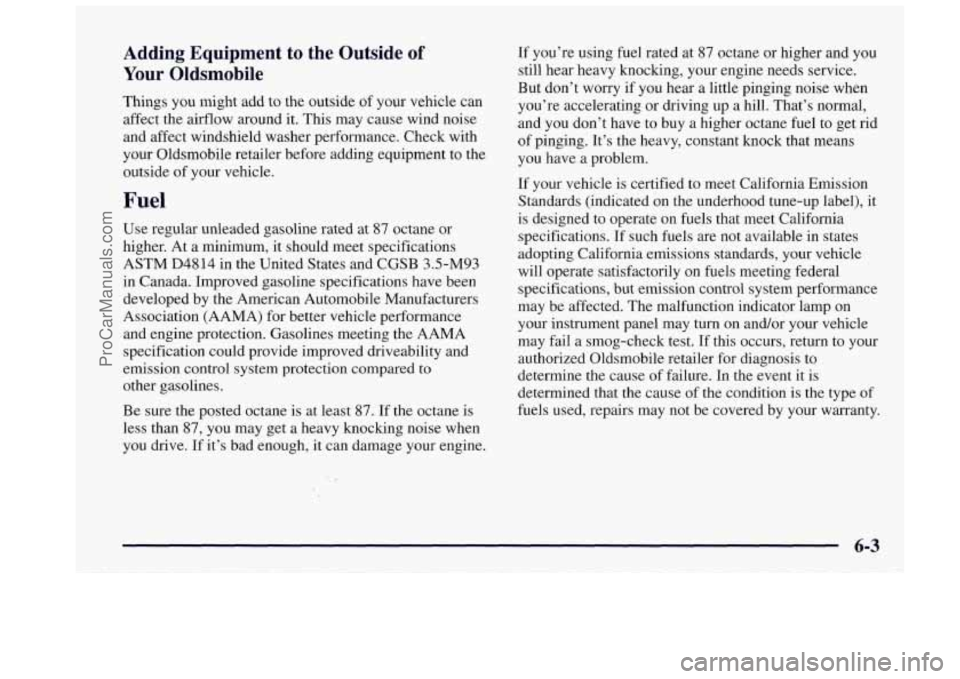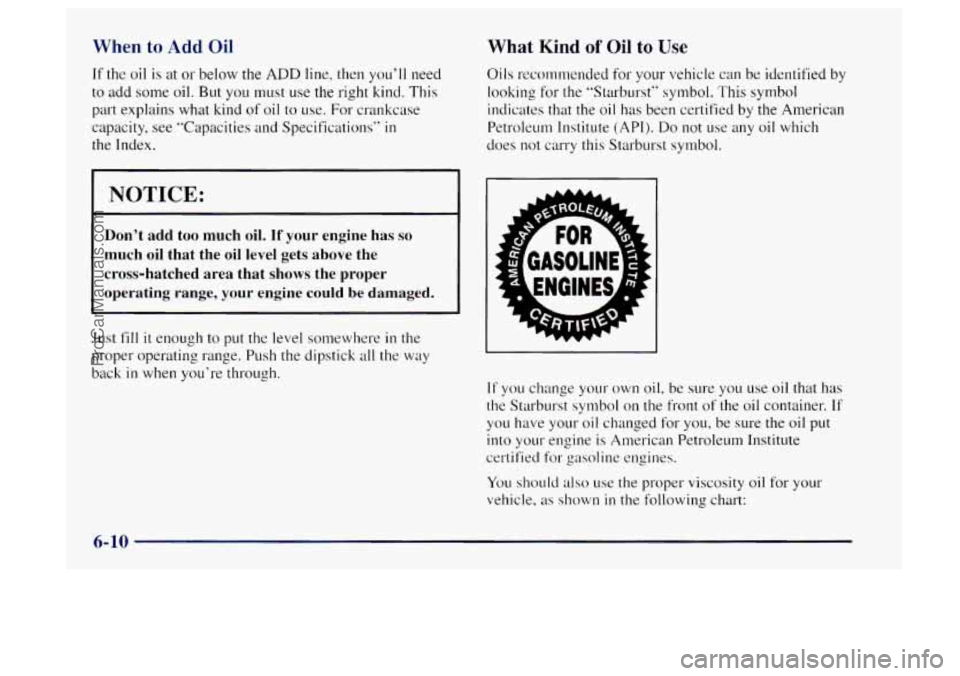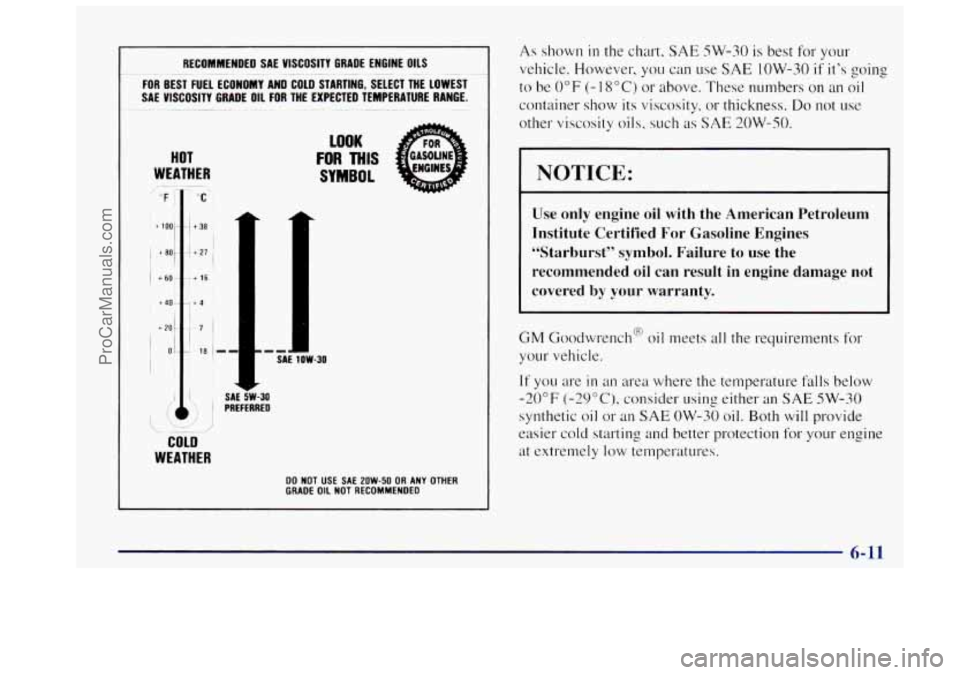engine OLDSMOBILE BRAVADA 1997 Repair Manual
[x] Cancel search | Manufacturer: OLDSMOBILE, Model Year: 1997, Model line: BRAVADA, Model: OLDSMOBILE BRAVADA 1997Pages: 358, PDF Size: 18.02 MB
Page 221 of 358

Section 6 Service and Appearance Care
Here you will find information about the care of your Oldsmobile. This section begins with service and fuel
information, and then it shows how to check important fluid and lubricant levels. There is also technical information
about
your vehicle, and a part devoted to its appearance care.
6-
2
6- 3
6-4
6-5
6-6
6-9
6- 14
6-20
6- 24
6-25
6-29
6-29
6-30
6-34
6-37 Doing
Your Own Service Work
What Kind of Fuel to Use
Using Fuel
in Foreign Countries
Where to Put the Fuel and Filling
the Tank
Checking Things Under the Hood
Checking Your Engine Oil
Automatic Transmission Fluid
Engine Coolant
Where to Fill
the Windshield Washer Fluid
Important Brake Information
Information
on Your Vehicle’s Battery
Tips
on Vehicle Storage
Bulb Replacement Procedures
Windshield Wiper Blade Replacement How and When
to Check Tire Inflation 6-39
6-42
6-44
6-47
6-48
6-50
6-5
1
6-52
6-53
6-54
6-55 6-59
6-60
6-60
6-6
I
When it is Time to Buy New Tires
Wheel Alignment
Cleaning the Inside
of Your Oldsmobile
Care
of the Safety Belts
Cleaning the Outside
of Your Oldsmobile
How to Clean Aluminum Wheels
Underbody Maintenance
Recommended Appearance Care Materials
Your Vehicle Identification Number
(VIN)
The Electrical System
Fuses and Circuit Breakers
Replacement Bulb Types for Your Vehicle
Capacities and Specifications
Normal Replacement Parts
Air Conditioning Specifications
6-1
- -~ -
ProCarManuals.com
Page 223 of 358

Adding Equipment to the Outside of
Your Oldsmobile
Things you might add to the outside of your vehicle can
affect the airflow around
it. This may cause wind noise
and affect windshield washer performance. Check with
your Oldsmobile retailer before adding equipment to the outside of your vehicle.
Fuel
Use regular unleaded gasoline rated at 87 octane or
higher. At a minimum, it should meet specifications
ASTM D4814 in the United States and CGSB 3.5-M93
in Canada. Improved gasoline specifications have been developed by the American Automobile Manufacturers
Association
(MA) for better vehicle performance
and engine protection. Gasolines meeting the AAMA
specification could provide improved driveability and
emission control system protection compared to
other gasolines.
Be sure the posted octane is at least
87. If the octane is
less than 87, you may get a heavy knocking noise when
you drive.
If it’s bad enough, it can damage your engine.
If you’re using fuel rated at 87 octane or higher and you
still hear heavy knocking, your engine needs service.
But don’t worry if you hear a little pinging noise when
you’re accelerating or driving up a hill. That’s normal,
and you don’t have to buy a higher octane fuel to get rid
of pinging. It’s the heavy, constant knock that means
you have a problem.
If your vehicle is certified to meet California Emission
Standards (indicated on the underhood tune-up label), it
is designed to operate on fuels that meet California
specifications. If such fuels are not available in states
adopting California emissions standards, your vehicle
will operate satisfactorily on fuels meeting federal
specifications, but emission control system performance
may be affected. The malfunction indicator lamp on
your instrument panel may
turn on and/or your vehicle
may fail a smog-check test. If this occurs, return to your
authorized Oldsmobile retailer for diagnosis to
determine the cause of failure. In the event it is
determined that the cause of the condition is the type of
fuels used, repairs may not be covered by your warranty.
ProCarManuals.com
Page 224 of 358

Some gasolines that are not reformulated for low
emissions contain an octane-enhancing additive called
methylcyclopentadlenyl manganese tricarbonyl
(MMT);
ask your service station operator whether or not his fuel
contains MMT. General Motors does not recommend the
use of such gasolines.
If fuels containing MMT are used,
spark plug life may be reduced and your emission
control system performance may be affected. The
malfunction indicator lamp on your instrument panel
may turn on. If this occurs, return to your authorized
Oldsmobile retailer for service.
To provide cleaner air, all gasolines
in the United States
are now required to contain additives that will help
prevent deposits from forming in your engine and
fuel
system, allowing your emission control system to
function properly. Therefore, you should not have to add
anything to the fuel.
In addition, gasolines containing
oxygenates, such
as ethers and ethanol, and
reformulated gasolines may be available in your area
to
help clean the air. General Motors recommends that you
use these gasolines if they comply with the
specifications described earlier.
NOTICE:
Your vehicle was not designed for fuel that
contains methanol. Don’t use it. It can corrode
metal parts in your fuel system and also damage
plastic and rubber parts. That damage wouldn’t
be covered under your warranty.
~~
Fuels in Foreign Countries
If you plan on driving in another country outside the United
States or Canada, the proper fuel may be hard to find. Never
use leaded gasoline or any other
fuel not recommended in the
previous text
on fuel. Costly repairs caused by use of
improper fuel wouldn’t be covered by your warranty.
To check on fuel availability, ask an auto club, or
contact
a major oil company that does business in the
country where you’ll be driving.
You can also write us at the following address for
advice. Just tell
us where you’re going and give your
Vehicle Identification Number
(VIN).
General Motors Overseas Distribution Corporation,
North American Export Sales (NAES)
1908 Colonel Sam Drive
Oshawa, Ontario L1H 8P7
6-4
ProCarManuals.com
Page 227 of 358

Then go to the front of the vehicle and release the
secondary
hood release.
Lift the hood, release the hood prop from its retainer and
put the hood prop into the slot
in the hood. You may
have a lamp that cornes on when you lift the hood.
A CAUTION:
Things that burn can get on hot engine parts and
start a fire. These include liquids like gasoline,
oil, coolant, brake fluid, windshield washer and
other fluids, and plastic
or rubber. You or others
could be burned. Be careful not to drop or spill
things that will burn onto a hot engine.
I
6-7
-
ProCarManuals.com
Page 228 of 358

When you lift the hood, you'll see these items:
A. Battery
B. Coolant Recovery Tank
C. Engine Oil Dipstick
D. Automatic Transmission Dipstick G. Brake Master Cylinder
E. Engine Oil Fill H. Air Cleaner
F. Power Steering Reservoir
I. Windshield Washer Fluid
6-8
ProCarManuals.com
Page 229 of 358

*--
Before closing the hood, be sure all the filler caps are on Checking Engine Oil
properly. Then lift the hood to relieve pressure on the
hood prop.
Remove the hood prop from the slot
in the hood and keeping the tip down, and check the level.
return the prop to its retainer. Pull
out the dipstick and clean it with a paper towel or
’ , . . cloth, then push it back in all the way. Remove it again,
--
Then just pull the hood down firmly to close. It will
latch when dropped from
10 to12 inches (25 to 30 cm)
without pressing on the hood.
Engine Oil
It’s a good idea to check your engine oil every time you
get fuel.
In order to get an accurate reading, the oil must
be warm and the vehicle must be
on level ground.
The oil dipstick is a
yellow ring.
Turn off the engine and give
the
oil a few minutes to
drain back into the oil pan.
If you don’t, the oil dipstick
might not show the
actual level.
6-9
ProCarManuals.com
Page 230 of 358

When to Add Oil
If the oil is at or below the ADD line, then you’ll need
to add some oil. But you must use the right kind. This
part explains what kind
of oil to use. For crankcase
capacity,
see “Capacities and Specifications” in
the Index.
NOTICE:
Don’t add too much oil. If your engine has so
much oil that the oil level gets above the
cross-hatched area that shows the proper
operating range, your engine could be damaged.
Just fill it enough to put the level somewhere in the
proper operating range. Push the dipstick all the way
back
in when you’re through.
What Kind of Oil to Use
Oils recom~nended for your vehicle can be identified by
looking
for the ”Starburst” symbol. This symbol
indicates that the oil has been certified by the American
Petroleum Institute
(API). Do not use any oil which
does not carry this Starburst symbol.
If you change your own oil, be sure you use oil that has
the Starburst symbol on the front of the oil container.
If
you have your oil changed for you, be sure the oil put
into your engine is American Petroleum Institute
certified for gasoline engines.
You should also use the proper viscosity oil for your
vehicle,
as shown in the following chart:
6-10
ProCarManuals.com
Page 231 of 358

I 1
RECOMMENDED SAE VISCOSITY GRADE ENGINE OILS
FOR BEST FUEL ECONOMY AND COLD STARTING, SELECT THE LOWEST
SAE VISCOSITY GRADE OIL
FOR THE EXPECTED TEMPERATURE RANGE.
~- - -. ~ -. . ~ .- . ~ .~ ~.. ~- ..
HOT
WEATHER , . . . .. .-
"F -I x
LOOK
FOR MIS
SYMBOL
-30
00 NOT USE SAE 2DW-50 OR ANY OTHER GRADE OIL NOT RECOMMENDED
As shown in the chart. SAE SW-30 is best for your
vehicle. However, you can use
SAE 1OW-30 if it's going
to be
0" F (- 1 8 " C) or above. These numbers on an oil
container show its viscosity, or thickness. Do not LIS(;:
other viscosity oils, such as SAE 20W-SO.
I NOTICE:
Use only engine oil with the American Petroleum
Institute Certif'ied For Gasoline Engines
"Starburst" symbol. Failure to use the
recommended oil can result in engine damage not
covered
by your warranty.
GM Goodwrench@ oil meets all the requirements for
your vehicle.
If you are in a11 area where the temperature fills below
-20°F (-29°C). consider using either an SAE SW-30
synthetic oil or an SAE OW-30 oil. Both will provide
easier cold starting and better protection for engine
at extremely
low temperatures.
6-11
ProCarManuals.com
Page 232 of 358

Engine Oil Additives
Don’t add anything to your oil. Your Oldsrnobile retailer
is ready to advise
if you think something should
be added.
When to Change Engine Oil
If any one of these is true for you, use the short tripkity
maintenance schedule:
a
a
a
a
a
Most trips are less than 5 to 10 miles (8 to 16 km).
This
is particularly important when outside
temperatures are below freezing.
Most trips include extensive idling (such
as frequent
driving
in stop-and-go traffic).
You operate your vehicle in dusty areas or
off-road frequently.
You frequently tow a trailer or use a carrier on top of
your vehicle.
The vehicle is used for delivery service, police, taxi
or other commercial application. Driving under these conditions causes
engine
oil to
break down sooner.
If any one of these is true for your
vehicle, then you need
to change your oil and filter
every
3,000 miles (5 000 km) or 3 months -- whichever
occurs first.
If none of them is true, use the long trip/highway
maintenance schedule. Change the oil and filter every
7,500 miles (1 2 500 km) or 12 months -- whichever
occurs first. Driving a vehicle with a
fully warmed
engine under highway conditions causes engine oil to
break down slower.
Remote Oil Filter
The access door for the remote oil filter is in the steering
linkage shield assembly located under the radiator
support. Twist the screw to unlock
or lock the door.
Make sure
if you open the door, it is securely closed
when
you are finished.
ProCarManuals.com
Page 233 of 358

What to Do with Used Oil
Did you know that used engine oil contains certain
elements that may be unhealthy for your skin and could
even cause cancer? Don‘t let used oil stay on your skin
for very long. Clean your skin and nails with soap
and
water, or a good hand cleaner. Wash or properly throw
away clothing or rags containing used engine oil. (See
the manufacturer’s warnings about the use and disposal
of oil products.)
Used
oil can be a real threat to the environment. If you
change your own oil, be sure to drain all free-flowing oil
from the filter before disposal. Don’t ever dispose of oil
by putting
it in the trash, pouring it on the ground, into
sewers, or into streams or bodies of water. Instead,
recycle
it by taking it to a place that collects used oil. If
you have a problem properly disposing of your used oil,
ask your retailer, a service station or a local recycling
center for help.
Air Cleaner
To remove the air cleaner, remove the wing nuts that
hold the cover on. Remove the cover and
lift out the
air filter.
Insert
a new air filter, then replace the air cleaner cover.
Tighten the wing nuts to hold the cover
in place.
Refer to the Maintenance Schedule to determine when to
replace the air filter.
See “Scheduled Maintenance Services” in the Index.
6-13
ProCarManuals.com